Facebook has been the hot-button topic of social and political discussions for the past few weeks.
Even still, more than 2 billion people still use the platform monthly, totaling to 50 million hours of usage.
But reaching those users without paying a now massively increased advertising cost still feels next to impossible.
Organic reach rates are stuck at a few measly percent. And with a new Facebook update, reporting (albeit not actual rates) will show even lower organic reach rates.
To top it all off, social engagements are down 50 percent in just the last three years.
But that doesn’t mean you can’t ignite engagement on Facebook. And despite the deck being stacked against you, it doesn’t mean you should choose the flight response.
Here’s how to use four unconventional methods to reclaim your lost organic reach.
1. Host a Live Webinar or Create a Static Video Series
BuzzSumo’s 2018 Content Trends Report found some interesting data, to say the least:
From 2015 to 2017, social shares have dropped 50 percent. With that, referral traffic and sales from social took a considerable hit, too.
“The majority of content gets zero backlinks.”
Yikes.
Even clickbait techniques aren’t working to drive engagement.
But all hope isn’t lost:
“In this new world of content saturation and falling social shares, the big winners are sites that have built a strong reputation for original, authoritative content.”
Let’s face it: we all saw this coming. The reason that Buzzsumo found such massive declines is that people don’t care about your daily blog posts in their feed anymore.
Nobody wants to see it. It’s boring, tiresome and the same old stuff regurgitated by hundreds of different companies vying for attention.
Think about it this way:
You’re scrolling down your Facebook feed, and you see a video of a bunch of puppies. You scroll further and see a boring blog post about SEO tips.
The odds of you ditching the puppies for SEO tips is next to nothing. I mean, it’s puppies, first of all.
The fact is, if you don’t put stock into diverse, high-quality content, you won’t drive shares.
If it’s easy to do, like pasting a link and hitting publish, it probably isn’t going to be your cash cow.
The first ever banner ad had a CTR of 78 percent. Now? Nowhere near it. And maybe a few years ago you could slide by with a simple tweet of your latest piece, but not anymore.
Now, the most engaging and appreciated content on Facebook is video-based. Native Facebook video content reaches an average of almost 17 percent of your audience. Even pasting YouTube videos into Facebook drops that engagement to 11 percent.
On top of static video content, Facebook Live videos generate more interactions. And some of the top companies in the B2B marketing space are taking advantage of this shift and change in the status quo.
For example, HubSpot runs live webinars and keynote presentations on trending topics in the marketing space:
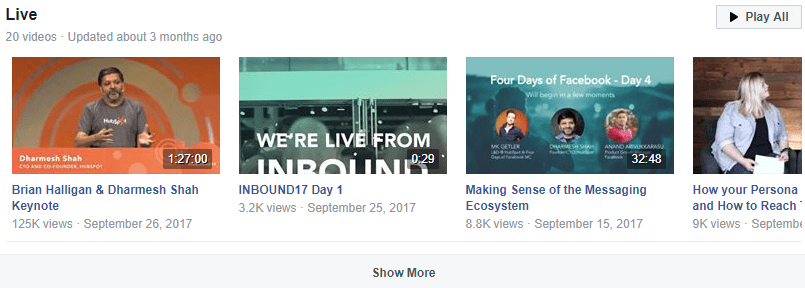
Pulling in hundreds of thousands of views on their content, their reach is far more amplified than typical blog post promotions.
Buffer uses the same strategy but focuses their content on static videos series where they tackle blog post style topics:

Even sports moguls like Tom Brady and the Ball Family have started their own Facebook series’ to drive massive online engagements and build active communities.
Facebook thrives on video content. So simply sharing your blog posts isn’t going to cut it. It might drive a few visits, but nothing that really moves the needle or contributes to growth.
Look at your current content and brainstorm ways to repurpose those pieces into new mediums.
For example, can you take your latest blog post on XX tactics for SEO and turn that into a round-table, live webinar on Facebook Live?
Can you instead break down long-form blog posts into a multi-part series on SEO?
You get the point: get creative and develop video-based assets that people want to come back to.
2. Post WAY LESS Than You Think You Should
You just spent hours and days perfecting your latest piece of content.
It’s been drafted ten times and proofread by everyone within a coffee-shops distance of you.
You head to your blog, upload your post and hit publish.
Naturally like any good marketer in 2018, you head over to your favorite social tool and share it on every single social media profile you’ve got.
You schedule it to reshare six times in the next two months.
Now you wait, wait, wait and reap the rewards of easy traffic!
But not anymore. Simply spamming your blog posts and repeating the process doesn’t drive reach on Facebook anymore.
We’ve always been taught that more is better. Post more blog content to drive more traffic. Share it more often on social to get more backlinks. Share it again and again in different ways with different titles.
But it doesn’t work anymore.
In fact, posting dramatically less in frequency and only focusing on top-tier pieces is going to generate huge boosts in reach.
Don’t take my word for it.
Social media tool Buffer put their own Facebook reach on the line to test a theory. Seeing subpar engagement as most of us are, they decided to reduce their daily Facebook posting from almost five times per day to barely more than one a day.
They were posting five times a day simply because organic reach was so bad. They needed to reach more users, and the only solution was to post more often to compensate for less reach.
Makes sense, right?
But reducing their posts to just one time a day from five resulted in doubling their organic reach. Engagements on their content doubled too.
“Today, we’re reaching more than 150,000 people per week on Facebook, compared to the 44,000 or so people that we were reaching during most of 2016.”
With posting less, Buffer focuses on their highest quality content meant to build brand awareness.
For example, Buffer utilizes branded video content developed from scratch:

They also curate content from leading publications like Business Insider to draw in users from those networks and provide more relevance on their page:
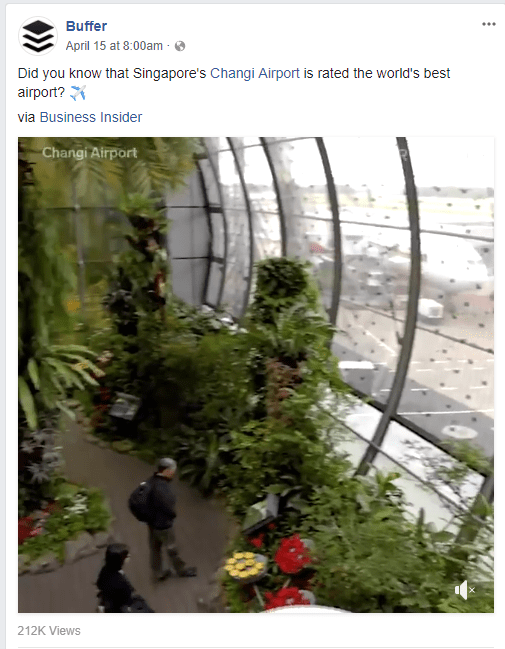
Taking advantage of popular content topics and mediums like travel and wanderlust, they develop content that centers on the cornerstone of their brand: sharing adventure with the world of social media.
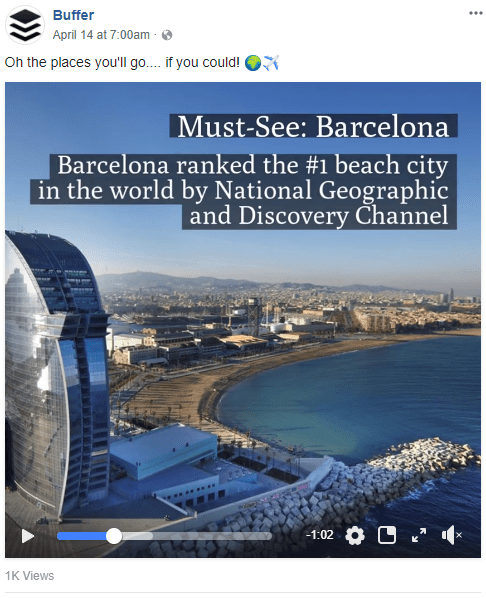
The secret to more organic reach isn’t to post more. It’s actually to post way less than you’re comfortable with. But it’s also about making those posts count by creating better content designed just for Facebook.
3. Engage with Every Comment & Build a Loyal Community
I know what you’re thinking: is this guy crazy?
You mean actually reply to each comment and strike up real conversations with people?
Ain’t nobody got time for that.
But if you want any hope at really igniting your organic reach, it’s one of the biggest ways to make a serious impact on your traffic.
During a Facebook Webinar in February, Facebook made a big statement with this slide:

Meaningful social interactions are critical to Facebook success.
So thinking you can just post your content in five seconds and call it a day and generate 100 new leads isn’t going to happen. Even just getting more temporary organic reach won’t result in lasting reach.
Reach + interactions are both key.
According to HootSuite, your content will be more likely to rank higher and get viewed if you have more natural engagements. Likes, comments, and replies to comments.
Start engaging with people. Strike conversations and build a community that wants to talk to you.
Brian Dean of Backlinko is a master of this, engaging with every comment on each of his Facebook posts:
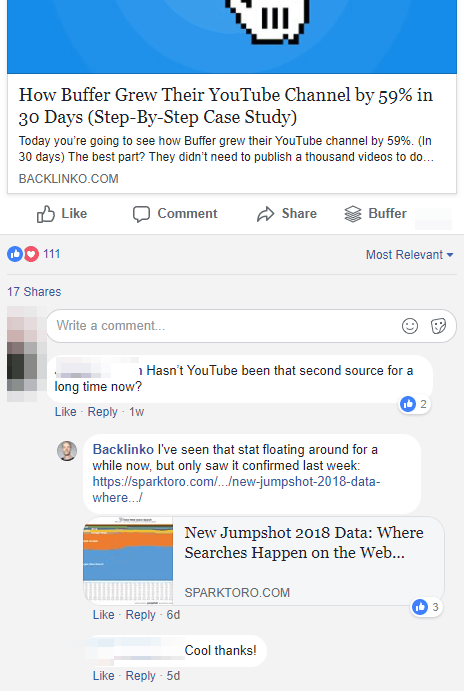
One entrepreneur of Lake Providence Lodge is able to drive $3,000 every month in sales from Facebook alone by focusing on creating a tight-knit community that she engages with on a daily basis.
Digital marketing often steers us in the wrong direction. It makes us think that more is better. More traffic. More posts. More content.
But sometimes, it just requires you to step back and hone in on the most important aspect of building your business: the customers.
4. Optimize Your Organic Audience Targeting
Facebook’s organic algorithm prioritizes highly-engaging content. And highly-engaging content stems from the right audience.
Sharing SEO tips with a PPC-based audience likely isn’t going to boost your engagement or comments.
Even with diverse audience targeting options on paid channels with Facebook, the majority of small businesses still miss their target audience.
And that likely carries over directly to organic efforts. If you can’t reach your target audience through affinities, demographics and interests/exclusions, it’s tough to ensure that your entire organic audience really cares about what you have to offer.
Thankfully, with a handy little tool, you can limit your audience targeting on every single post without paying a dime.
On your company page, before hitting “Publish” to post, click on the globe icon:
![]()
From here, select the “Demographics” option:

First, you can limit your audience by demographic factors like age, gender, location, and languages:
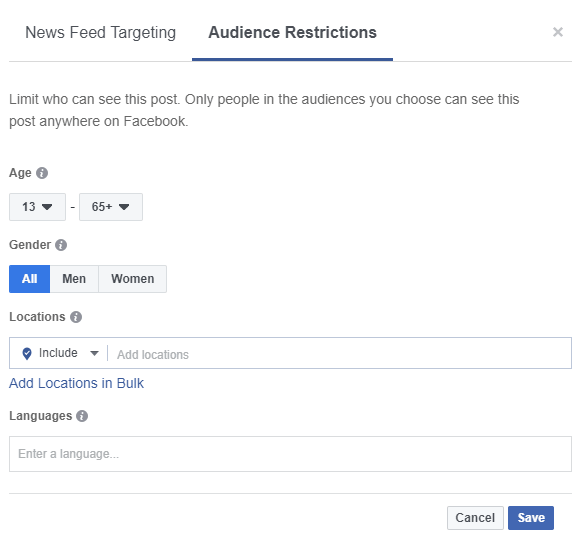
Depending on what content you post and what markets your brand caters to, this can be vastly useful.
But the real meat and potatoes lie in the news feed targeting section, where you can edit interests and “More Demographics” like relationship status and even education level.

While not foolproof, it significantly narrows your audience to ensure that the right targets see the right content.
Before your next post on Facebook, test your audience factors and see how engagement compares to generalized posting. You can even try using audience insights on Facebook to generate market segments if you’re feeling adventurous.
Don’t miss your targets and ensure that each post is reaching the right audience.
Conclusion
Brands like HubSpot and Buffer are proving that organic reach is still a viable way to grow traffic and leads and build valuable brand awareness.
Fighting a decline in organic reach require unconventional methods that require more effort.
They require dedication to the platform as a whole and creating content specifically for it.
Start testing live webinars and video series on Facebook. Post less often and focus on high-quality content instead of using more posts to mitigate a lack of reach.
Build an engaged audience that can learn to trust you and seek your content on their own time.
And lastly, never send a post without optimizing your organic audience.
Facebook organic reach sucks. But it’s far from dead. Now is the time to reclaim it.
More Facebook Marketing Resources:
- How to Use Facebook Page Insights Like an Expert
- Facebook Video Tips: 12 Ideas for More Engagement
- 4 Powerful Facebook Ads Targeting Options
Image Credits
Featured Image: rawpixel/Pixabay.com
Screenshots by Brad Smith. Taken May 2018.





